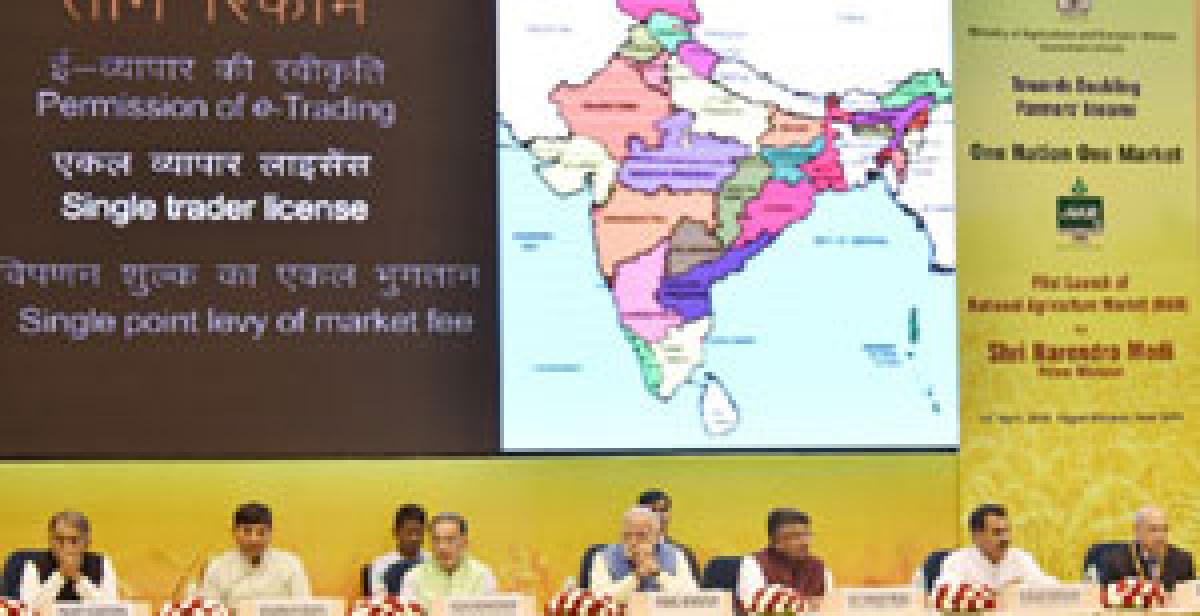Live
- Indian GenAI startups see 6 times surge in funding in Q2
- Revanth is a liar: Errabelli
- Big B pens heartfelt note for Abhishek’s work in latest film: You are Arjun Sen
- BGT 2024-25: India on brink of victory in Perth as Australia reach 227/8 at tea
- SC grants 4 weeks more to Centre to decide Balwant Singh Rajoana’s mercy plea
- Lucky for me to end up with PBKS under head coach Ponting: Stoinis
- Students pay the price for govt apathy
- Naini for new vistas to captivate people
- Can Food Cravings Impact Your Mental Health?
- Skincare and Air Pollution: 5 Simple Tips to Protect Your Skin from Toxic Air
Just In

major concern is that a unified market project of this scale has not been attempted before in India. At best, what India has seen is an operational e-marketing platform in Hubli in Karnataka for e-trading of agricultural produce. Therefore, the need is to tread cautiously and meticulously on how challenges may arise in market functioning.
Among the inefficiencies that hobble the agriculture sector is the structure of the market. Middlemen and traders distort the market structure and often the farmers do not have the freedom and the resources to sell across the length and breadth of the country. This often reduces what a truly competitive market can achieve for the farmers. This is where the farmers often get sub-optimal prices for their produce.
The union government recently initiated the National Agriculture Market (NAM) scheme, which envisages creating an e-platform for connecting 585 mandis or wholesale markets for agricultural produce across the length and breadth of the country.
At the initial stage, the scheme envisages implementation of NAM by the Department of Agriculture & Cooperation (DAC) through the Small Farmers Agribusiness Consortium (SFAC) by creating a common electronic platform deployable in selected regulated markets across the country.
The important point is that the scheme is voluntary and is to be carried out in three phases covering 250, 200 and 135 mandis during 2015-16, 2016-17 and 2017-18 respectively. Private mandis can access the e-market platform but will not be provided funds for infrastructure or equipment.
The overall scheme is aimed at expanding the freedom to sell depending on greater price realizations for farmers. Overall the NAM scheme will bring in transparency and align demand and supply and will help farmers get appropriate price depending on the market dynamics in the overall national unified market.
However, there are two or three concerns in the project which will have to be tackled effectively.
These include the fact that the states will have to be taken on board for this. The respective Agricultural Produce Market Committee Acts will have to be amended for enabling the creation of the unified market.
Second, another major concern is that a unified market project of this scale has not been attempted before in India. At best, what India has seen is an operational e-marketing platform in Hubli in Karnataka for e-trading of agricultural produce. Therefore, the need is to tread cautiously and meticulously on how challenges may arise in market functioning.
Finally, there is an issue of coverage which will have to be sorted out as the scheme gathers momentum. Initially, 25 crops will be traded across eight states in 21 mandis. The increase in coverage will help more farmers avail of the benefits of the platform. The e-NAM will eventually lead to more freedom to sell by farmers to traders across India in a competitive market. The aim of the government to double agricultural incomes by 2022 might just come closer if the functioning of the markets for agricultural commodities can be improved.

© 2024 Hyderabad Media House Limited/The Hans India. All rights reserved. Powered by hocalwire.com







